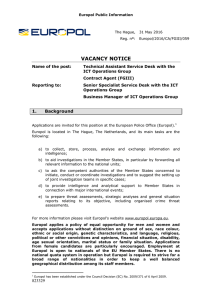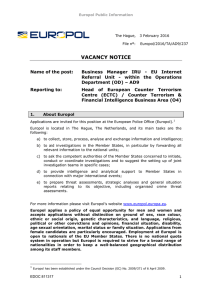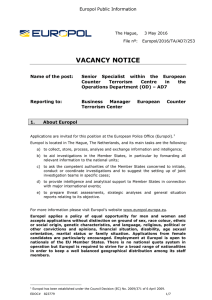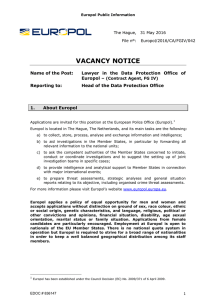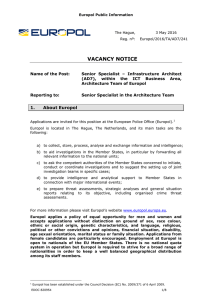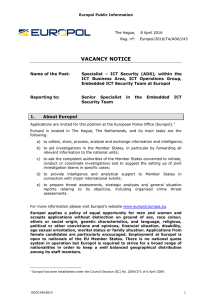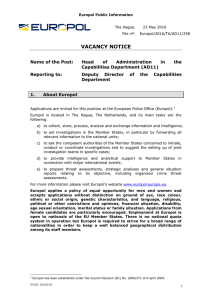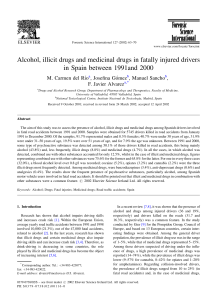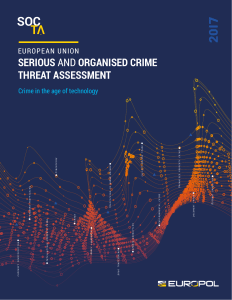European Union Drugs Strategy - Council of the European Union
Anuncio
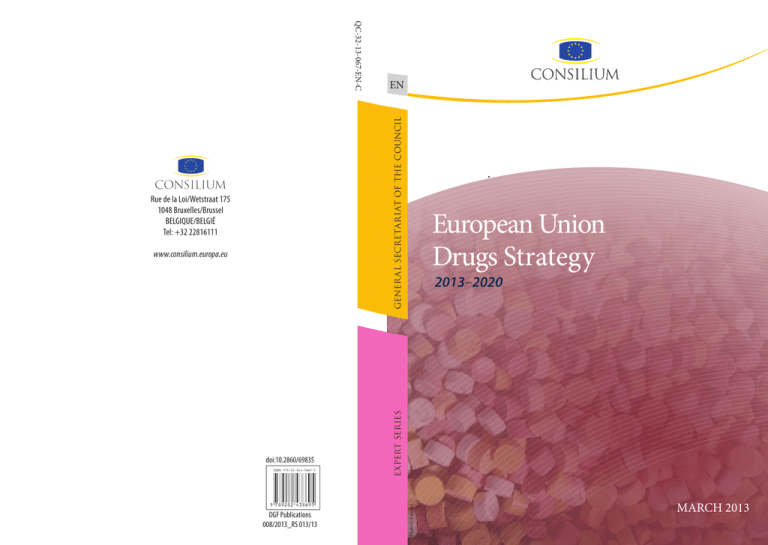
GENER AL SECRETARIAT OF THE COUNCIL QC-32-13-067-EN-C EN doi:10.2860/69835 DGF Publications 008/2013_RS 013/13 2013–2020 Photo:© Europol www.consilium.europa.eu European Union Drugs Strategy RS /2011 EXPERT SERIES Rue de la Loi/Wetstraat 175 1048 Bruxelles/Brussel BELGIQUE/BELGIË Tel: +32 22816111 MARCH 2013 European Union Drugs Strategy 2013–2020 MARCH 2013 Notice This brochure is produced by the General Secretariat of the Council and is intended for information purposes only. For information on the European Council and the Council, you can consult the following websites: www.european-council.europa.eu www.consilium.europa.eu or contact the Public Information Department of the General Secretariat of the Council at the following address: Rue de la Loi/Wetstraat 175 1048 Bruxelles/Brussel BELGIQUE/BELGIË Tel. +32 22815650 Fax +32 22814977 www.consilium.europa.eu/infopublic More information on the European Union is available on the Internet (http://europa.eu). Cataloguing data can be found at the end of this publication. Luxembourg: Publications Office of the European Union, 2013 ISBN 978-92-824-3869-5 doi:10.2860/69835 © European Union, 2013 Reproduction is authorised provided the source is acknowledged. Printed in Belgium Printed on ecological paper Contents PREFACE. . . . . . . . . . . . . . . . . . . . . . . . . . . . . . . . . . . . . . . . . . . . . . . . . . . . . . . . . . . . 5 I. INTRODUCTION. . . . . . . . . . . . . . . . . . . . . . . . . . . . . . . . . . . . . . . . . . . . . . . . . 7 II. POLICY FIELD: DRUG DEMAND REDUCTION. . . . . . . . . . . . . . . . . . . . . . 11 III. POLICY FIELD: DRUG SUPPLY REDUCTION . . . . . . . . . . . . . . . . . . . . . . 15 IV. CROSS-CUTTING THEME: COORDINATION. . . . . . . . . . . . . . . . . . . . . . . 19 V. CROSS-CUTTING THEME: INTERNATIONAL COOPERATION. . . . . . . . 23 VI. CROSS-CUTTING THEME: INFORMATION, RESEARCH, MONITORING AND EVALUATION. . . . . . . . . . . . . . . . . . . . . . . . . . . . . . . . . 29 3 PREFACE This EU Drugs Strategy provides the overarching political framework and priorities for EU drugs policy identified by Member States and EU institutions, for the period 2013-20. The framework, aim and objectives of this Strategy will serve as a basis for two consecutive 4-year EU Drugs Action plans. This Drugs Strategy is based first and foremost on the fundamental principles of EU law and, in every regard, upholds the founding values of the Union: respect for human dignity, liberty, democracy, equality, solidarity, the rule of law and human rights. It aims to protect and improve the well-being of society and of the individual, to protect public health, to offer a high level of security for the general public and to take a balanced, integrated and evidence-based approach to the drugs phenomenon. The Strategy is also based on international law, the relevant UN Conventions1 which provide the international legal framework for addressing the illicit drugs phenomenon and the Universal Declaration on Human Rights. This EU Drugs Strategy takes into account relevant UN political documents, including the UN Political Declaration and Action Plan on International Cooperation towards an Integrated and Balanced Strategy to Counter the World Drug Problem, adopted in 2009, which states that drug demand reduction and drug supply reduction are mutually reinforcing elements in illicit drugs policy and the UN Political Declaration on HIV/AIDS. The Strategy has been drafted on the basis of the principles set out in the Lisbon Treaty and on the respective competences of the Union and individual Member States. Due regard is given to subsidiarity and proportionality, as this EU Strategy intends to add value to national strategies. The Strategy shall be implemented in accordance with these principles and competencies. Furthermore, the Strategy respects fully the European Convention on Human Rights and the EU Charter of Fundamental Rights. 1The UN Single Convention on Narcotic Drugs of 1961 as amended by the 1972 protocol, the Convention on Psychotropic Substances (1971) and the Convention against the Illicit Traffic in Narcotic Drugs and Psychotropic Substances (1988). 5 By 2020, the priorities and actions in the field of illicit drugs, encouraged and coordinated through this EU Drugs Strategy, should have achieved an overall impact on key aspects of the EU drug situation. They shall ensure a high level of human health protection, social stability and security, through a coherent, effective and efficient implementation of measures, interventions and approaches in drug demand and drug supply reduction at national, EU and international level, and by minimising potential unintended negative consequences associated with the implementation of these actions. The drugs phenomenon is a national and international issue that needs to be addressed in a global context. In this regard, coordinated action carried out at EU level plays an important role. This EU Drugs Strategy provides a common and evidence-based framework for responding to the drugs phenomenon within and outside the EU. By providing a framework for joint and complementary actions, the Strategy ensures that resources invested in this area are used effectively and efficiently, whilst taking into account the institutional and financial constraints and capacities of Member States and of the EU institutions. The Strategy aims to contribute to a reduction in drug demand and drug supply within the EU, as well as a reduction as regards the health and social risks and harms caused by drugs through a strategic approach that supports and complements national policies, that provides a framework for coordinated and joint actions and that forms the basis and political framework for EU external cooperation in this field. This will be achieved through an integrated, balanced and evidence-based approach. Finally, this Strategy builds on the lessons learned from the implementation of previous EU Drugs Strategies and associated Action Plans, including the findings and recommendations from the external evaluation of the EU Drugs Strategy 2005-12, while taking into account other relevant policy developments and actions at EU level and international level in the field of drugs. 6 I. INTRODUCTION The Strategy takes on board new approaches and addresses new challenges which have been identified in recent years, including: –the increasing trend towards poly-substance use, including the combination of licit substances, such as alcohol and prescribed controlled medication, and illicit substances; –the trends towards non-opioid drug use as well as the emergence and spread of new psychoactive substances; –the need to ensure and improve access to prescribed controlled medications; –the need to improve the quality, coverage and diversification of drug demand reduction services; –the continued high incidence of blood-borne diseases, especially hepatitis C virus, among injecting drug users and potential risks of new outbreaks of HIV infections and other blood-borne diseases related to injecting drugs use; –the continuing high prevalence of numbers of drug-related deaths within the EU; –the need to target drug use through an integrated health care approach addressing — inter alia — psychiatric co-morbidity; –the dynamics in the illicit drug markets, including shifting drug trafficking routes, cross-border organised crime and the use of new communication technologies as a facilitator for the distribution of illicit drugs and new psychoactive substances; –the need to prevent diversion of precursors, pre-precursors and other essential chemicals used in the illicit manufacture of drugs from legal trade to the illicit market and the diversion of certain chemicals used as cutting agents. 7 The objectives of the EU Drugs Strategy are: –to contribute to a measurable reduction of the demand for drugs, of drug dependence and of drug-related health and social risks and harms; –to contribute to a disruption of the illicit drugs market and a measurable reduction of the availability of illicit drugs; –to encourage coordination through active discourse and analysis of developments and challenges in the field of drugs at EU and international level; –to further strengthen dialogue and cooperation between the EU and third countries and international organisations on drug issues; –to contribute to a better dissemination of monitoring, research and evaluation results and a better understanding of all aspects of the drugs phenomenon and of the impact of interventions in order to provide sound and comprehensive evidence-base for policies and actions. The Strategy builds upon the achievements1 made by the EU in the field of illicit drugs and is informed by an ongoing, comprehensive assessment of the current drug situation in particular that provided by the EMCDDA, while recognising the need to proactively respond to developments and challenges. The Strategy is structured around two policy areas; drug demand reduction and drug supply reduction, and three cross-cutting themes: (a) coordination, (b) international cooperation and (c) research, information, monitoring and evaluation. Its two consecutive Action Plans, drafted by corresponding Presidencies in 2013 and 2017, will provide a list of specific actions with a timetable, responsible parties, indicators and assessment tools. Taking due account of the current drugs situation and the implementation needs of the Strategy, a limited number of targeted actions will be selected on each of the two policy areas and three cross-cutting themes, for inclusion in the Action Plans based on criteria which include the following: (a) actions must be evidence-based, scientifically sound and cost-effective, and aim for realistic and measurable results that can be evaluated; 1Report on the independent assessment of the EU Drugs Strategy 2005-12 and its action plans (http://ec.europa.eu/justice/anti-drugs/files/rand_final_report_eu_drug_ strategy_2005-2012_en.pdf) 8 © Africa Studio - Fotolia.com (b) actions will be time-bound, have associated benchmarks, performance indicators and identify responsible parties for their implementation, reporting and evaluation; (c) actions must have a clear EU relevance and added value. To safeguard a continued focus on the implementation of the Strategy and of its accompanying Action Plans, each Presidency, with the support of the Commission and the technical input from EMCDDA and Europol shall address priorities and actions that require follow up in the HDG during its term and shall monitor progress. The Commission, taking into account information provided by the Member States, the European External Action Service (EEAS), and available from the EMCDDA, Europol and other EU bodies, as well as from the civil society, shall provide biannual progress reports, with the purpose of assessing the implementation of objectives and priorities of the EU Drugs Strategy and its Action Plan(s). The Commission, taking into account information provided by the Member States and available from the EMCDDA, Europol, other relevant EU institutions and bodies and civil society, will initiate an external midterm assessment of the Strategy by 2016, in view of preparing a second Action Plan for the period 2017-20. Upon conclusion of the Drugs Strategy and its Action Plans by 2020, the Commission will initiate an overall external evaluation of their implementation. This evaluation should also take into account information gathered from the Member States, the EMCDDA, Europol, other relevant EU institutions and bodies, civil society, and 9 previous evaluations in order to provide input and recommendations for the future development of EU drugs policy. To reach its objectives and to ensure efficiency, the EU Drugs Strategy 2013–20 will use, wherever possible, existing instruments and bodies operating in the drug field, within the respective mandate, or that have relevance for key aspects of it, both within the EU (in particular the EMCDDA, Europol, Eurojust, the European Centre for Disease Prevention and Control (ECDC) and the European Medicines Agency (EMA) and collaboration with bodies outside the EU (such as UNODC, WCO, WHO and the Pompidou Group). The Commission, the High Representative, the Council, the European Parliament will ensure that the EU’s activities in the field of illicit drugs are coordinated and that they complement each other. Appropriate and targeted resources should be allocated for the implementation of the objectives of this EU Drugs Strategy at both EU and national level. 10 II.POLICY FIELD: DRUG DEMAND REDUCTION Drug demand reduction consists of a range of equally important and mutually reinforcing measures, including prevention (environmental, universal, selective and indicated), early detection and intervention, risk and harm reduction, treatment, rehabilitation, social reintegration and recovery. In the field of drug demand reduction, the objective of the EU Drugs Strategy 2013-20 is to contribute to the measurable reduction of the use of illicit drugs, to delay the age of onset, to prevent and reduce problem drug use, drug dependence and drug-related health and social risks and harms through an integrated, multidisciplinary and evidence-based approach, and by promoting and safeguarding coherence between health, social and justice policies. In the field of drug demand reduction, the following priorities (not listed in the order of priority) are identified. 1. Improve the availability, accessibility and coverage of effective and diversified drug demand reduction measures, promote the use and exchange of best practices and develop and implement quality standards in prevention (environmental, universal, selective and indicated), early detection and intervention, risk and harm reduction, treatment, rehabilitation, social reintegration and recovery. 2. Improve the availability and effectiveness of prevention programmes (from initial impact to long-term sustainability), and raise awareness about the risk of the use of illicit drugs and other psychoactive substances and related consequences. To this end, prevention measures should include early detection and intervention, promotion of healthy lifestyles and targeted prevention (i.e. selective and indicated) directed also at families and communities. 3. Scale up and develop effective demand reduction measures to respond to challenges such as: polydrug use including the combined use of licit and illicit substances, misuse of prescribed controlled medications and the use of new psychoactive substances. 11 4. Invest in and further research on effective risk and harm reduction measures aimed at substantially reducing the number of direct and indirect drug-related deaths and infectious blood-borne diseases, associated with drug use, but not limited to, HIV and viral hepatitis as well as sexually transmittable diseases and tuberculosis. 5. Expand the availability, accessibility and coverage of effective and diversified drug treatment across the EU to problem and dependent drug users including non-opioids users, so that all those who wish to enter drug treatment can do so, according to relevant needs. © Artem Furman - Fotolia.com 6. Scale up the development, availability and coverage of drug demand reduction measures in prison settings, as appropriate and based on a proper assessment of the health situation and the needs of prisoners, with the aim of achieving a quality of care equivalent to that provided in the community and in accordance with the right to health care and human dignity as enshrined in the European Convention on Human Rights and the EU Charter of Fundamental Rights. Continuity of care should be ensured at all stages of the criminal justice system and after release. 12 © Mykola Mazuryk - Fotolia.com 7. evelop and expand integrated models of care, covering needs related D to mental and/or physical health-related problems, rehabilitation and social support in order to improve and increase the health and social situation, social reintegration and recovery of problem and dependent drug users, including those affected by co-morbidity. 8. Develop effective and differentiated drug demand reduction measures that aim to reduce and/or delay the onset of drug use and that are appropriate to the needs of specific groups, patterns of drug use and settings, with particular attention to be paid to vulnerable and marginalised groups. 9. Prevent local and regional drug use epidemics, which may threaten the public health within the EU by ensuring coordinated and effective common approaches. 10. Drug demand reduction priorities need to take into account the specific characteristics, needs and challenges posed by the drug phenomenon at national and EU level. It is imperative that an appropriate level of resources is provided for that purpose at local, national and EU level. 13 III. POLICY FIELD: DRUG SUPPLY REDUCTION Drug supply reduction includes the prevention and dissuasion and disruption of drug-related, in particular organised, crime, through judicial and law enforcement cooperation, interdiction, confiscation of criminal assets, investigations and border management. In the field of drug supply reduction, the objective of the EU Drugs Strategy 2013–20 is to contribute to a measurable reduction of the availability of illicit drugs, through the disruption of illicit drug trafficking, the dismantling of organised crime groups that are involved in drug production and trafficking, efficient use of the criminal justice system, effective intelligence-led law enforcement and increased intelligence sharing. At EU level, emphasis will be placed on large-scale, cross-border and organised drug-related crime. In the field of drug supply reduction, the following priorities (not listed in the order of priority) are identified. 1. Strengthen the cooperation and coordination between law enforcement agencies at strategic and operational level. This should include, but not be limited to, improving cross-border exchange of information (and intelligence) in real time, best practices and knowledge, as well as conducting joint operations and investigations. Cooperation with third countries as regards tackling drug-related organised crime operating towards and within the EU should be seen as important in this respect. 2. Reduce intra-EU and cross-border production, smuggling, trafficking, distribution and sale of illicit drugs and the facilitation of such activities, as well as reduce the diversion of drug precursors, pre-precursors and other essential chemicals used in the illicit manufacture of drugs. 3. Respond effectively to the evolving trends, such as the diversion of certain chemicals utilised as cutting agents for illicit drugs and the supply of drugs through the use of new technology. 15 © Oris-Multimedia DPTO Audiovisuales 4. Special attention must be given to new communication technologies as having a significant role as a facilitation for the production, marketing, trafficking and distribution of drugs (including controlled new psychoactive substances). 5. Member States shall continue to cooperate, and coordinate — where appropriate — their actions at EU level, together with relevant EU and international bodies and agencies, such as Europol, Eurojust, EMCDDA and fully exploit existing instruments and methods provided in the field of judicial and law enforcement cooperation, such as intelligence-led policing, drug profiling, Joint Investigation Teams, Joint Customs and Police Operations and relevant initiatives such as the EMPACT projects, Liaison Officer Platforms and through the use of regional platforms. 6. At EU level, emphasis shall be placed on intelligence-led law enforcement aimed at targeting large-scale drug production and trafficking. Closer coordination and cooperation between law enforcement agencies within and between Member States as well as with Europol should be further strengthened. 7. Where necessary, when such tasks are not initiated or implemented through Europol, ad hoc regional collaboration initiatives or platforms may be created within the EU, to counter emerging threats from shifting 16 drug trafficking routes and emerging organised crime hubs. This shall be done by means of coordinated operation responses. Such actions need to be compatible with and complementary to existing legal and operational arrangements at EU level and shall be based on threat assessments and analysis. Such cooperation structures should be flexible, may have a temporary lifespan depending on the future development of the specific threat that they address and work in close cooperation with all relevant EU agencies and platforms, in particular with Europol. 8. Strengthen, where deemed necessary, the EU drug-related judicial and law enforcement cooperation and the use of existing practices by establishing faster and more accurate responses. Support judicial and law enforcement cooperation activities and exchange of information and intelligence. © Europol 9. Reinforce the European Union’s legislative framework in a targeted way as deemed necessary so as to strengthen the EU response in dealing with new trends, ensure that collaborative efforts complement each other with a view to dismantle cross-border organised crime groups, confiscate the proceeds of drug-related crime by fully utilising the EU network of asset recovery offices and thus ensure a more effective response to drug trafficking. The further development of relevant law enforcement instruments can be explored. 17 10. The EU shall work towards more effective policies in the field of drug supply reduction, by reinforcing policy evaluation and analysis to improve the understanding of drug-markets, drug-related crimes and the effectiveness of drug-related law enforcement responses. © Europol 11. In order to prevent crime, avoid recidivism and enhance the efficiency and effectiveness of the criminal justice system while ensuring proportionality, the EU shall encourage, where appropriate, the use, monitoring and effective implementation of drug policies and programmes including arrest referral and appropriate alternatives to coercive sanctions (such as education, treatment, rehabilitation, aftercare and social reintegration) for drug-using offenders. 18 IV. CROSS-CUTTING THEME: COORDINATION In the field of EU drugs policy, the objective of coordination is twofold, namely to ensure synergies, communication and an effective exchange of information and views in support of the policy objectives, while at the same time encouraging an active political discourse and analysis of developments and challenges in the field of drugs at EU and international levels. Coordination is required within and among EU institutions, Member States, other relevant European bodies and civil society on the one hand, and between the EU, international bodies and third countries on the other hand. In the field of coordination, the following priorities (not listed in the order of priority) are identified. 1. Ensure synergies, coherence and effective working practices among relevant Member States, EU institutions, bodies and initiatives, based on the principle of sincere cooperation1, avoiding duplication of efforts, securing efficient exchange of information, using resources effectively and guaranteeing continuity of actions across Presidencies. 2. Given the role of the HDG as the main drugs coordinating body within the Council, its coordinating efforts need to be further strengthened to take account of the work of the various bodies, that include a drugs component such as the Standing Committee on Operational Cooperation on Internal Security (COSI) and the Working Party on Public Health. In addition, the balanced approach to the drugs problem, targeting with equal vigour the demand for and the supply of drugs, requires close cooperation, interaction and information exchange with relevant other Council preparatory bodies including those in the area of external action and other relevant EU initiatives, in the areas of judicial and criminal matters, law enforcement, public health, social affairs. 1 TEU article 4. 19 3. Ensure that the EU and Member States further develop and implement working methods and best practices for multidisciplinary cooperation in support of the objectives of the Strategy and that these are promoted at national level. © Europol 4. Provide opportunities under each Presidency to discuss, monitor and evaluate issues of coordination, cooperation, emerging trends, effective interventions and other policy developments of added value to the EU Drugs Strategy for instance during the National Drugs Coordinators’ Meetings. 20 © EU 5. Promote and encourage the active and meaningful participation and involvement of civil society, including non-governmental organisations as well as young people, drug users and clients of drug-related services, in the development and implementation of drug policies, at national, EU and international level. Also to ensure the engagement with the EU Civil Society Forum on Drugs at EU and international level. 6. Ensure that the EU speaks with one strong voice in international forums such as the Commission on Narcotic Drugs (CND) and in dialogues with third countries, promoting the integrated, balanced and evidence-based EU approach to drugs. In this framework, the EU Delegations can play a useful role in promoting such approach in the field of drugs and in facilitating a coherent discourse on drugs policy. 21 V. C ROSS-CUTTING THEME: INTERNATIONAL COOPERATION I nternational cooperation is a key area where the EU adds value to Member States efforts in coordinating drug policies and addressing challenges. The EU external relations in the field of drugs are based on the principles of shared responsibility, multilateralism, an integrated, balanced and evidence-based approach, the mainstreaming of development, respect for human rights and human dignity and respect for international conventions. The objective of the EU Drugs Strategy 2013–20 in the field of international cooperation, is to further strengthen dialogue and cooperation between the EU and third countries and international organisations on drug issues in a comprehensive and balanced manner. The EU Drugs Strategy is part of an overall approach that enables the EU to speak with one voice in the international arena and with the partner countries. The EU will remain committed to international cooperation and debate on the fundamentals of drug policy, and actively share the achievements of the EU approach in drug policy that is balanced between drug demand reduction and drug supply reduction, based on scientific evidence and intelligence as well as respecting human rights. This requires coherence between policies and actions at the EU level, including external cooperation on drug demand reduction, including risk and harm reduction, drug supply reduction, alternative development, the exchange and transfer of knowledge and the involvement of both state and non-state actors. The EU and its Member States should guarantee the integration of the EU Drugs Strategy and its objectives within the EU’s overall foreign policy framework as part of a comprehensive approach that makes full use of the variety of policies and diplomatic, political and financial instruments at the EU’s disposal in a coherent and coordinated manner. The High Representative supported by the EEAS should facilitate this process. 23 © EU The EU external action approach in the field of drugs aims to further strengthen and support third countries’ efforts to deal with the challenges to public health, safety and security. This will be done through the implementation of initiatives set out in this Strategy and subsequent action plans, including alternative development, drug demand reduction, drug supply reduction, the promotion and protection of human rights and also taking into account regional initiatives. Given the impact of drug production and trafficking on the internal stability and security situation in source and transit countries, actions will also target corruption, money laundering and the proceeds of drug-related crime. In the field of international cooperation, the following priorities (not listed in the order of priority) are identified. 1. Improve coherence between the internal and external aspects of the EU drugs policies and responses towards third countries in the field of drugs. 2. Increase the EU’s engagement and coordination in the international drug policy discourse, both in respect of negotiations with international organisations and structures including the UN, G8 and the Council of Europe and relations with third countries by achieving common EU positions, and ensure an effective role within the UN drug policy process. 3. Ensure that international cooperation in the field of drugs is integrated within the overall political relations and framework agreements between the EU and its partners, both at national and/or regional level. It should reflect the integrated, balanced and evidence-based EU approach and include: political dialogue, drug coordination, demand reduction (including risk and harm reduction), supply reduction 24 © EU © EU including alternative development and law enforcement, integration of drug policies within the broader development cooperation agenda, information, research, monitoring and evaluation. 4. Ensure that the EU international response and actions in priority third countries and regions around the world are comprehensive taking into account every dimension of the drug phenomenon, and address the development, stability and security of these countries and regions through enhanced partnership. 5. Ensure that the EU international drug response is evidence-based and includes a monitoring process on the situation and progress involving different information tools from the Commission, EEAS, including the 25 EU Delegations, Member States, EMCDDA, Europol, Eurojust and the European Centre for Disease Prevention and Control in close cooperation with UNODC. 6. Ensure that support to the candidate and potential candidate countries, and the countries of the European Neighbourhood Policy, focuses on capacity-building on both supply and demand reduction and evidencebased, effective and balanced drug policies, through strengthened cooperation including sharing of EU best practices and participation, where appropriate, in EU agencies, such as the EMCDDA, Europol and Eurojust. 7. Ensure a sustainable level of policy dialogue and information sharing on the strategies, aims and relevant initiatives through the dialogues on drugs with international partners, both at regional and bilateral level. Key partners are identified on the basis of their status of cooperation with the EU and their relevance in addressing the global illicit drug phenomenon while taking account of partners emerging as a result of developments in the drug situation. The Political Dialogues should be complementary to and coherent with other external cooperation structures and their impact and, where appropriate, provide a forum for discussing priorities on cooperation and progress on EU-funded projects. 8. Ensure an appropriate level of funding and expertise (provided for by the EU and its Member States) including by reinforcing coordination, monitoring and evaluation of financial and technical support, while striving for synergies and by continuously balancing the transparent allocation of cooperation, resources, financial and technical assistance, between drug demand and drug supply reduction measures reflecting the EU approach. The EU should work towards providing relevant expertise in EU Delegations to support the implementation of measures targeting third countries in the field of drugs. The midterm review and final assessment of this EU Drugs Strategy should reflect on the impact of EU spending in third countries and the Commission and the EEAS should provide updates on priorities and progress on the EU spending overseas to Member States when appropriate. 9. When providing financial and technical support to source countries, the EU and Member States shall ensure, in particular, that alternative development programmes: –are non-conditional, non-discriminating and, if eradication is scheduled, properly sequenced, 26 –set realistic rural development-related objectives and indicators for success, ensuring ownership among target communities and –support local development, while considering interactions with factors such as human security, governance, violence, human rights, development and food security. © Europol 10. Ensure that the protection of human rights is fully integrated in political dialogues and in the implementation and delivery of relevant programs and projects in the field of drugs. 27 28 © Michael Ireland-Fotolia.com VI. C ROSS-CUTTING THEME: INFORMATION, RESEARCH, MONITORING AND EVALUATION The objective of the EU Drugs Strategy 2013-20 in the field of information, research, monitoring and evaluation is to contribute to a better understanding of all aspects of the drugs phenomenon and of the impact of measures in order to provide sound and comprehensive evidence for policies and actions. Furthermore, the EU Drugs Strategy 2013-20 aims to contribute to a better dissemination of monitoring, research and evaluation results at EU and national level ensuring the strengthening of synergies, a balanced allocation of financial resources and avoiding duplication of efforts. This can be achieved through harmonisation of methodologies, networking and closer cooperation. In the field of information, research, monitoring and evaluation the following priorities (not listed in the order of priority) are identified. 1. The EU and its Member States should continue to invest in information exchange, data collection and monitoring, and in research and evaluation of the drug situation and responses to it at national and EU level. This should cover all relevant aspects of the drug phenomenon, including drug demand and drug supply. Particular emphasis should be placed on maintaining and further enhancing data collection and reporting through the EMCDDA key indicators in drug demand reduction. 2. The EMCDDA should, within its mandate, further enhance the knowledge infrastructure and should continue to play a key role as the central facilitator, supporter and provider of information, research, monitoring and evaluation of illicit drugs across the EU. It should continue to provide a timely, holistic and comprehensive analysis of the European drugs situation and of responses to it, and collaborate with other relevant agencies, including, when relevant and appropriate, the European Centre for Disease Control (ECDC) and the European Medicines Agency (EMA) and WHO. 29 © benjaminnolte - Fotolia.com 3. Europol should continue its efforts as regards information gathering and analysis in the area of drug-related organised crime, while Member States should deliver relevant information to the Agency. The Agency should continue the regular delivery of threat assessment reports (e.g. EU SOCTA) on EU drug-related organised crime. 4. Member States, EU institutions and agencies should enhance information and data collection on all aspects of drug supply, including on drug markets, drug-related crimes and drug supply reduction with the aim to improve analysis and informed decision making. Member States, the Commission, EMCDDA, Europol and — where appropriate — other EU agencies should work together to improve data collection and the development of policy-relevant and scientifically sound indicators. 5. The EU institutions, bodies and Member States should improve the capacity to detect, assess and respond rapidly and effectively to the emergence of new psychoactive substances, to behavioural changes in drugs consumption and epidemic outbreaks and to other emerging trends that pose risks to public health and safety. This can be achieved, inter alia, through the strengthening of existing EU legislation, the exchange of information, intelligence, knowledge and best practices. 30 6. Member States, EU institutions and agencies should promote and support research, including applied research, into new psychoactive substances and ensure cooperation and coordination between networks at national and EU level in order to strengthen the understanding of the phenomenon. Monitoring in this area should be scaled up in close coordination with the EMCDDA. In particular, emphasis should be placed on developing forensic and toxicological capacity as well as on improving the availability of epidemiological information. 7. Member States should continue efforts to maintain the achievements made within the EU in terms of monitoring and information exchange, including through the Reitox Network of National Focal Points, while supporting the further development of EU standardised data collection and analysis in the areas of drug demand and drug supply. 8. Ensure adequate financing for drug-related research and development projects at EU and national level, according to financial resources including through the EU financial programmes covering the period 2014-20. Projects supported at EU level should take into account the priorities of the Strategy and its Action Plans and deliver a clear EU added value, ensuring coherence and synergies while avoiding duplication within programmes and with EU bodies. 9. EU institutions, bodies and Member States should recognise the role of scientific evaluation of policies and interventions (with a focus on outcomes achieved) as a key element in strengthening of the EU approach to drugs, and should promote its use both at national, EU and international level. 10. Ensure and reinforce training of professionals involved with drug-related issues, both in the drug demand as well as the drug supply reduction field. 31 HOW TO OBTAIN EU PUBLICATIONS Free publications: • via EU Bookshop (http://bookshop.europa.eu); • a t the European Union’s representations or delegations. You can obtain their contact details on the Internet (http://ec.europa.eu) or by sending a fax to +352 292942758. Priced publications: • via EU Bookshop (http://bookshop.europa.eu). Priced subscriptions (e.g. annual series of the Official Journal of the European Union and reports of cases before the Court of Justice of the European Union): • via one of the sales agents of the Publications Office of the European Union (http://publications.europa.eu/others/agents/index_en.htm). General Secretariat of the Council EU Drugs Strategy (2013–2020) Luxembourg: Publications Office of the European Union 2013 — 31 pp. — 14.8 x 21.0 cm ISBN 978-92-824-3869-5 doi:10.2860/69835 GENER AL SECRETARIAT OF THE COUNCIL QC-32-13-067-EN-C EN doi:10.2860/69835 DGF Publications 008/2013_RS 013/13 2013–2020 Photo:© Europol www.consilium.europa.eu European Union Drugs Strategy RS /2011 EXPERT SERIES Rue de la Loi/Wetstraat 175 1048 Bruxelles/Brussel BELGIQUE/BELGIË Tel: +32 22816111 MARCH 2013



